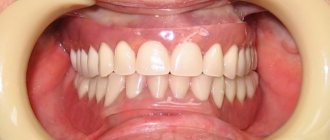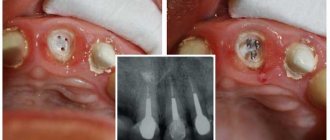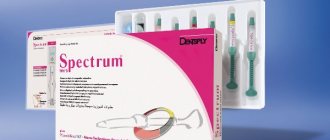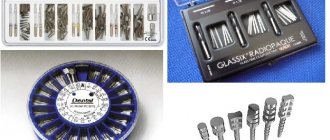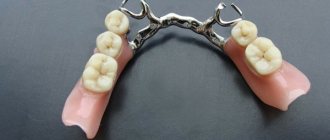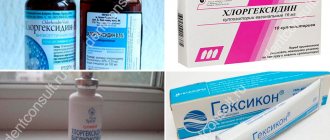If, due to caries or injury, a tooth is more than half destroyed, dentists resort to restoring it with the help of additional devices - in particular, using a titanium pin. It is installed in the root canal of the tooth to provide support for crowns made of artificial materials.
In appearance, the pin resembles a rod or a small screw. In dentistry it is used:
- to restore one unit in a row;
- when preparing abutment teeth for a bridge;
- when creating complex structures for splinting mobile teeth.
Contact numbers of our clinics:
Belorusskaya (+7
or Leave a request and we will call you back
Leave feedback
What is a pin in dentistry
This is a structure in the form of a rod, which is fixed in the root canal of a destroyed tooth. It serves as an element that ensures reliable adhesion of the root system to the composite material or artificial crown. The use of such a pin allows you to restore the crown part of the tooth in the presence of a living root in satisfactory condition. Before installing such a structure, the doctor must take into account the following points:
- degree of crown destruction and the possibility of fixing the rod in the root canal,
- expected load on the tooth,
- the depth to which the rod can be immersed in the channel.
Intracanal pins are different, they are made from various materials, and the choice of a specific model directly depends on the characteristics of the clinical picture. A separate niche is occupied by anchor models - rod clamps, which can be brass, titanium, made of an alloy of gold, platinum or stainless steel. They are the most durable and allow the restoration of an almost completely destroyed tooth, ensuring long-term results, including in the area of chewing molars.
Buy pins
, Russia
Intrachannel pins
- Intra-channel gold-plated pins (ball screws)
- Intrachannel titanium pins (SHVT)
- Intrachannel titanium anchor pins (SHVTA)
Titanium pins
- Titanium pins with 0.8 taper
Fiberglass pins
- Fiberglass pins (FGF)
- Cylindrical-conical pins
- Conical fiberglass pins
- Volume head pins
Keys for installing pins
- Phillips wrench for installing titanium pins
- Phillips wrench for installing brass pins
- Internal key for installing brass pins
- Mandrel (universal key)
Pin sets
- Set of brass gold-plated pins (ball screws)
- Set of intra-channel titanium anchor pins (SHVTA)
Tool used for installation of intra-channel cylindrical titanium pins (SHVTsT)
- Expansion drill (DR)
- Calibration drill (DK)
- Expanding tetrahedral drill (DDR)
- Channel filler (KN)
In what cases do you resort to installing an anchor rod?
If the visible part of a tooth is destroyed by more than 30%, it can be restored using filling materials, but it is not a fact that the result of such work will last long enough. By resorting to the help of an intracanal design, it is possible to achieve high adhesion strength of the restoration material or a full-fledged crown with the root system of the tooth, even if it is severely destroyed. It is important that the root canals are healthy, and then with the help of this design it is possible to save the damaged element.
The pin is used for partially destroyed teeth
Thus, anchor pins have found wide application in dental restoration in cases of destruction of varying degrees of complexity, including the almost complete absence of the external part of the element. Installation of the structure is possible if there are hard tissues at a height of at least 2-3 mm above the gum level. In addition, an x-ray must confirm the satisfactory condition of the root with a thickness of at least 2 mm1. Such a rod will ensure a more correct distribution of pressure on the tooth, restore its functionality and allow the patient to return to their normal lifestyle, without giving up solid foods.
Fiberglass pins
Fiberglass pins are distinguished by their particular strength, durability, elasticity, as well as light conductivity and radiopacity. These characteristics of fiberglass pins have led to their widespread use in aesthetic dental restoration. Compared to inelastic pins, when using such pins, the wedging load on the walls of the tooth root is minimized. Fiberglass posts are designed and manufactured in accordance with current trends in the dental industry and traditional quality standards.
Packing: 6 pcs. / same size.
Buy Fiberglass Pins
ShVS-105 (L1), ShVS-120 (L2), ShVS-135 (L3), ShVS-150 (L4), ShVS-165 (L5), price: 60.00 rub.
When installing a structure fails
It is not always possible for a specialist to install an anchor pin - there are a number of contraindications to its use. In addition to the fact that the clinical picture must meet the above requirements (2-3 mm of dental tissue above the gum level and at least 2 mm of root thickness), the patient should not have the following problems: chronic inflammatory processes in the soft tissues of the oral cavity, canal obstruction, neoplasms in the root area. Contraindications also include blood clotting disorders and disruptions in the functioning of the nervous system.
It is not possible to use with severely damaged teeth.
Set of intra-channel titanium anchor pins (SHVTA)
Set No. 1 (66 pcs.)
S | 1 | 2 | 3 | 6 pcs. M | 1 | 2 | 3 | 6 pcs. L | 1 | 2 | 3 | 6 pcs. XL | 4 | 6 | 6 pcs. Phillips key 1 pc. Internal key 1 pc.
Price: RUB 840.00
Set No. 2 (121 pcs.)
S | 1 | 2 | 3 | 11 pcs. M | 1 | 2 | 3 | 11 pcs. L | 1 | 2 | 3 | 11 pcs. XL | 4 | 6 | 11 pcs. Phillips key 1 pc. Internal key 1 pc.
Price: RUB 1,438.00
What are the types of in-ear components?
There is a fairly wide variety of pins used in dentistry. Accordingly, there are several main classifications of this type of structure. Today we are talking about the anchor rod, so next we will consider its main types.
Material from which the product is made
The anchor structure can be made of various metal alloys. Based on the material of manufacture, dental experts distinguish the following types: made from an alloy of gold or platinum, titanium, brass or stainless steel. Such products are used primarily for fixing artificial crowns; they are durable and quite reliable, although today specialists increasingly prefer modifications made from more modern materials, such as fiberglass. It is also worth noting that pins can be made of ceramics (an aesthetic option), gutta-percha, carbon fiber, but they are no longer classified as anchor systems.
Products can be made from various materials
Product installation method
Intra-channel rods are also divided according to the method of installation. In this regard, experts distinguish two independent varieties:
- active - there is a thread, due to which the product is fixed by screwing into the prepared area. The disadvantage of this technique is the increased risk of damage to the canal walls as a result of excessive pressure, and this entails the need to completely remove the root system,
- passive – fixed with special dental cement. The disadvantage of this method is the possible loss of the structure after a period of operation, due to the gradual weakening of the binding properties of the composition.
The second option is used much more often, since it avoids the risk of damage to the internal structures of the tooth. If this happens, the only solution will be to implant an implant - a full-fledged analogue of a tooth root, and this is a rather serious and expensive procedure.
Shape of the rod
In-channel anchor rods come in different shapes:
- conical - in such a product the base has a larger diameter and tapers towards the end, which allows for a reliable base for fixing the crown,
- cylindrical - the design has an equal diameter along the entire length and is mainly used for wide channels,
- cylindrical-conical - the wide base gradually tapers towards the end, but does not have a point, as is the case with the conical shape.
The shape of the product can be different.
Parameters, namely the shape and size of the structure, are selected individually, based on the characteristics of each individual clinical picture. The number of roots, the nature of the canal, its depth and the degree of tooth destruction are taken into account.
Types of titanium pins
Titanium pins in dentistry are classified according to several points:
- Shape: conical;
- cylindrical.
- smooth;
- passive;
Also, a titanium pin can be standard or customized. In the first case, we are talking about factory designs, which theoretically can be installed in any root. Individual pins are made personally taking into account the parameters of a particular tooth. They are more reliable, but due to manufacturing difficulties, prices for titanium pins of this type are correspondingly higher.
What are the advantages and disadvantages?
Anchor pins have found widespread use in dentistry, and for good reason. Here are the main advantages characteristic of this type of structure:
- strength and reliability - the retainer copes well with its main function, namely holding the restored part of the tooth or an installed crown, and can withstand fairly high chewing loads,
- reasonable cost in comparison with more modern varieties of similar products,
- the speed of the procedure, which usually does not take more than an hour,
- possibility of fixing a fully functional prosthesis – an artificial crown.
However, such products today are gradually fading into the background, as experts increasingly prefer improved modifications made from modern materials. Thus, the disadvantages of anchor structures include the risk of damage to the canal walls during installation, the possible negative influence of metals, including the risk of developing an allergic reaction, poor aesthetics - over time, the metal component will begin to show through. Such products are very firmly fixed with a cement composition and are sometimes difficult to remove, hence another problem - the likelihood of root perforation.
Indications and contraindications
The use of titanium pins is a popular technique in dentistry. In most cases, it allows you to cure even the most neglected teeth without resorting to their removal.
The main indications indicating the need for the procedure include the following:
- the crown received serious damage (the root was not damaged);
- it is necessary to create a reliable mount for installing the prosthesis;
- After eliminating caries, the destructive process of the tooth began.
In this case, the pins can be installed as a basis for subsequent treatment.
However, pinning also has a number of contraindications. The procedure is strictly contraindicated for patients who have cysts or granulomas. Significant curvature of the root canals, as well as a thin layer of the root wall, will also be a significant reason for refusing the procedure.
In the case of inflammatory processes, the pin is installed only after appropriate treatment.
How to install a pin - description of technology
After all the preparatory measures, diagnosis and choice of treatment tactics, the doctor proceeds directly to the procedure. To begin with, adjacent teeth are isolated, old filling material or tissues affected by caries are removed, the dental canal is treated and prepared, it is expanded if necessary, as well as complete antiseptic treatment of the tissues. This is usually followed by fitting - the doctor fixes the temporary product and directs the patient to take a picture to make sure that the element is installed in the correct position and to the required depth. If all is well, the temporary structure is removed and a permanent one is installed.
The photo shows a pin installed in a tooth.
The rod itself is carefully placed in the root canal using a special key, which is usually supplied in the kit. The threaded model is screwed in with extreme care to avoid damage to the canal walls. The passive variation is less demanding in this regard, and a cement composition is used for its reliable fixation. The tip of the rod remains above the gum line and serves as the basis for fixing the crown. All manipulations are performed under local anesthesia.
As for whether it is realistic to remove the anchor pin, the answer is yes, but with a caveat: the product is successfully removed using ultrasound, which destroys the binding properties of the cement, but there remains a fairly high risk of severe damage to the root. If this happens, it will have to be removed and subsequently implanted, and this is a much more expensive and serious procedure.
How to install the pin
First of all, a thorough diagnosis of the patient is carried out, during which the doctor will examine the oral cavity to determine if there are any problems that prevent the installation of the pin. After this, the dentist will move on to the procedure itself, which in Moscow is performed in stages:
- Anesthesia is administered, after which the root canals are cleaned and expanded;
- a special solution is poured into the expanded channels, after which the pin itself is inserted inside;
- the resulting void is filled, and the diseased tooth is dried with a halogen lamp;
- then, depending on the specifics of the procedure, a prosthesis is installed, which is fixed with permanent cement;
- the final stage is examination of the diseased tooth, grinding the enamel surface (if necessary).
Approximately 6 hours before the procedure, the patient should not eat any food.
Alternative restoration options
Many dentists today try to avoid anchors because they now have more modern and reliable products at their disposal that do not have many of the disadvantages inherent in metal rods. The priority is ceramics for the front teeth, as well as fiberglass - a durable and fairly elastic material that can withstand high loads, but without compromising the aesthetic component. Among the advantages of fiberglass products are the following:
- no risk of allergies,
- simple and safe installation,
- preservation of the walls of the root canal in the long term,
- ease of removal of the structure, and the possibility of its return in place after treatment,
- the ability to achieve high aesthetics during restoration,
- strength and reliability.
Fiberglass pin makes it possible to achieve high aesthetics in prosthetics
“I had one of my front teeth restored, and the doctor immediately said that it would be better to use a fiberglass pin. It is ideal for the smile area, does not show through over time, and holds firmly. In my case, the result exceeded all my expectations - the tooth is exactly the same as all the others, I don’t notice any differences. About a year passed and no visible changes occurred. And I’ve never heard of an allergy to fiberglass...”
Olga, from correspondence on the woman.ru forum
Fiberglass is absolutely resistant to the aggressive external environment of the oral cavity. In addition, this is an excellent option if the restoration is carried out without the use of prosthetic products, namely with the help of composite materials - the fibers have a matte white color, so they will not show through the composite and thereby spoil the appearance of the smile. Installation is less traumatic, and the risk of root damage remains minimal.
Classification of dental pins
What types of dental pins are there? In fact, there are many types of classification of such structures - depending on the location and features of installation, the type of material and its characteristics, shape and size according to ISO standards - from 10 to 140. Let's consider the classification further, and in the following sections we will dwell in detail on the most popular types designs.
Classification according to installation location:
- intracanal (the vast majority of structures): placed with the sharp part in the root canal or in all canals (if the tooth is multi-channel), and the upper one is located in the coronal part. Next, the restoration is filled and/or closed with an artificial crown,
- parapulpal (pins): suitable for installation only in the crown, without affecting the canals. In this case, the dental nerve, i.e. the pulp remains healthy and undamaged. Parapulpal pins, as a rule, are installed in the dentin layer along the edges of the natural crown and are slightly bent at the top and center of the tooth so that a filling can be built up on top. Parapulpal ones are made of metal (titanium, steel, gold) and can be active or passive.
By structural features:
- cone-shaped (rounded needle-shaped),
- cylindrical (rounded straight),
- flat,
- combined,
- anchor
By type of fixation:
- active: fastened by screwing - due to the features of the shape and thread. The apparent ease of installation is associated with the risk of complications and injuries to the root canals,
- passive: attached using adhesive (cement, composite or special glue).
According to the material:
- metal,
- carbon fiber,
- fiberglass,
- ceramic,
- gutta-percha,
- paper: this option is used only as an auxiliary one - for drying the cavity during installation.
The materials must be strong and elastic in order to withstand chewing pressure, but not injure their own tissues (in particular dentin). Also, the materials should not provoke allergies, but it is worth noting that some patients sometimes experience allergic reactions.
By elasticity:
- inelastic: metal, ceramic models,
- elastic: carbon, fiberglass varieties.
By manufacturing method:
- standard: manufactured at the factory,
- customized: made in the clinic for a specific patient. As a rule, stump inlays are already implied here.
%akc72%
Metal - composition and features
Metal is what the most popular non-elastic pins are made of. The metal alloy may include brass, stainless steel (inexpensive designs), as well as titanium, silver and gold. The advantages are ease of manufacture, high metal strength, low susceptibility to corrosion (for high-quality alloys). Disadvantages are the risk of damage to the roots under increased loads, and the material showing through the filling. Therefore, they are not used for restoration in the smile area under a filling - only under an artificial crown.
Silver is now practically not used, because... Over time it begins to corrode. And the products of this process stain the tooth gray.
Anchor - structure and purpose
Anchor pins for teeth are a subgroup of structures with a special shape. They can be made of medical steel, titanium, gold, brass, polymers, and can be gold plated. As a rule, metal is used most often. Anchor ones have a fairly large diameter and are somewhat similar to screws - i.e. cylinders with or without threads, which have a thickened head on top. This gives them the advantage of increased strength and stability of the restoration. The disadvantages of metal anchors include the risk of allergies, poor load distribution, which can cause injury to the root. But it is impossible to remove the anchor from the root.
Gutta-percha structures and their features
Gutta-percha is a flexible and elastic latex product that is used to produce round and flat conical dental posts. Although there is not so much gutta-percha itself in the composition - only about 20%. The rest is zinc oxide (up to 70%) and another 10% comes from additives - barium sulfate, wax, dye. Such designs are opaque, usually orange in color. Up to 30 gutta-percha pins can be inserted into one tooth, after which their tops are trimmed. There is gutta-percha for the “cold” method of installation, and there is “thermophilic”, which is heated with a special apparatus, due to which it softens and fills the smallest pores in the canals.
The advantages of gutta-percha include dense filling of the root canal and easy removal from it if necessary, low toxicity and good compatibility with the body. The disadvantages of the products are excessive softness and flexibility, which can cause problems during installation (if not handled correctly). The material may shrink over time, and it also does not have a bactericidal effect. When installing, you must use a sealer (special glue), otherwise the gutta-percha simply will not stick to the walls and will fall out.
Fiberglass - material and characteristics
Fiberglass passive pins for teeth are presented in the form of a thin translucent white rod. How are they made? These advanced third-generation elastic structures are made by weaving very fine glass strands or quartz glass strands and immersing them in an epoxy matrix. Popular manufacturers are RelyX Fiber Post from 3M ESPE, Easy Post from Dentsply Maillefer, fiberglass from the domestic manufacturer IKADENT.
The advantages lie in high aesthetics, because the rod does not show through the filling at all. The material is quite strong, elastic, and it does not provoke allergies and does not injure the root canals under stress. The disadvantages of fiberglass include high cost and lower strength compared to metal. Another disadvantage is the risk of structural fracture due to errors during installation.
Carbon fiber (or carbon, carbon, carbon fiber, C-post)
Carbon fibers are made on a carbon basis and have characteristics close to fiberglass, except for the color - here it is black. The rod consists of a multi-axial bundle of interwoven carbon fibers bound together with a composite compound. Such structures are elastic, resilient, do not injure the root canal tissues and distribute the chewing load well, i.e. reduce the likelihood of cracks and fractures.
Carbon fiber structures are suitable for passive fixation. They are not visible in ultraviolet light, but are clearly visible on an x-ray, which allows you to evaluate the quality of the installation. Disadvantage: It is not recommended to place a filling on the front teeth. A popular brand (and the only one in our country) is Carbonite from Nordin.
Zirconium Dioxide Ceramic Products
Zirconium dioxide or metal-free ceramics is a very durable material from which dental crowns, core and restorative inlays, and even implants are made. In addition to excellent strength properties, this material has high aesthetics - white color, which makes it suitable for restoration of any area of the dentition. Another advantage is hypoallergenicity. The only disadvantage is the high cost of the material. Such structures are manufactured by Nordin under the Zirix brand.
Possible complications
Installation of the anchor pin is usually quick and without complications. Problems may arise due to the patient's allergy to metals. In such a situation, swelling usually develops, the gums in the area of the restored tooth turn red, and itching appears. If such symptoms are detected, you should immediately contact your dentist to remove the structure. If a specialist made mistakes during the treatment process or carried out insufficiently high-quality antiseptic treatment, there may be a risk of developing an inflammatory process - stomatitis, periodontitis.
Swelling after treatment may be a sign of complications
Immediately after the procedure, when the anesthesia wears off, discomfort and moderate pain may appear - this is a completely natural phenomenon, a reaction to tissue injury that inevitably occurs during root canal treatment and restoration of a damaged tooth. The symptoms will go away after a couple of days, but in the meantime, pharmaceutical painkillers will help alleviate the condition. If the pain and intensity of symptoms only increases, it is better to see a specialist. Perhaps the whole point is damage to the walls of the root canal.
Stages of installation of the structure
Before placing a pin in a tooth, you need to prepare the canals and eliminate contraindications. If you plan to install an intracanal pin, then you need to completely remove the nerve and affected tissue, and cure the inflammation under the roots. And then carry out obturation - closing the canals with special filling compounds. Before installing the parapulp structure, the areas of enamel and dentin affected by caries should be carefully drilled out. In any case, preparation is accompanied by x-ray control - this is how the condition of the pulp and ligamentous apparatus is assessed, cysts and granulomas are identified, and the quality of obturation is determined.
After the preparatory stage, you can begin to install the structure. How is a pin screwed into a tooth and does it hurt? There shouldn't be any pain, because... treatment is carried out with an injection of anesthetic. Or on a previously pulpless root without an injection, because the tooth is already “dead”, i.e. there is no nerve in it that would respond to stimuli. The pin is inserted after part of the filling compound is removed from the top of the canal - approximately 2/3 is removed, and the lower third remains hermetically sealed. Here, special reamers are used that give the channel a conical or cylindrical shape.
Care after installation
After the restoration, the specialist will definitely give detailed recommendations regarding care during rehabilitation and recovery. So, for about a week it is better to stop eating solid foods and using toothpicks.
In the future, care should be taken to treat the restored tooth, trying to protect it from excessive mechanical loads and traumatic factors. An important condition is responsible adherence to the rules of hygiene: regular brushing of teeth twice every day, rinsing the mouth after meals, systematic visits to the dentist for preventive examinations.
Proper dental hygiene is important to maintain your smile.
Complications and features of rehabilitation
If the dentist carried out the installation with violations of the technology, or the patient developed an allergic reaction, or the rod simply broke due to its thinness, then it is necessary to remove it. But this is not always possible due to the characteristics of the material of the structure and the depth of its immersion in the channel. How is a tooth with a pin removed? Here everything goes as standard - an anesthetic injection is given, the tooth is “swinged” with forceps and removed from the socket. But this does not apply to all structures - but only, for example, to anchor ones. You can try to remove the elastic ones with forceps or tweezers after chemically softening the adhesive composition.
How much does an anchor pin cost?
This type of rod refers to financially affordable solutions. Installation of a stainless steel structure will cost the patient an average of 400 rubles. If the product is made of titanium, the price will increase to approximately 600 rubles. Titanium rods with gold plating cost about 800-1000 rubles. You need to understand that this is only the cost of the structure itself and its installation. Tooth restoration will require additional costs for x-ray examination, anesthesia, canal treatment and filling, possibly depulpation if it has not been carried out previously, as well as restoration with composite materials or the manufacture and installation of a crown.
An anchor pin is a reliable and proven solution that allows you to restore even a severely damaged tooth and fully restore its functionality. However, today many dentists are inclined to use rods made of more modern and aesthetic materials, which are often not inferior to metal structures in terms of strength and service life. In any case, the choice of one type of product or another should be based on the individual characteristics of the clinical picture, so it is better to entrust this task to a specialist.
- Adialkhanyan V.A. Features of tooth restoration after endodontic treatment, 2003.
Intrachannel titanium anchor pins (SHVTA)
Commonly used titanium pins (with a composite head), intra-channel titanium anchor pins (with a cross head).
Packing: 12pcs. / same size.
Buy intrachannel titanium anchor pins (SHVTA)
S1,S2,S3,S4,S5,S6, price: 168.00 rub.
M1,M2,M3,M4,M5,M6, price: 168.00 rub.
L1,L2,L3,L4,L5,L6, price: 168.00 rub.
XL1,ХL2,XL3,XL4,XL5,ХL6, price: 168.00 rub.
Using the pin
Most often, pins are made of a special titanium alloy, which provides the product with maximum strength, exceptional lightness and compatibility with the human body.
For more than 25 years, titanium pins have been used in dentistry to correct the consequences of dental injuries if:
- it is possible to restore using an artificial crown and install a special support for it;
- a large coronal part is destroyed, up to the edges of the gums;
- it is necessary to increase the strength of the tooth and its resistance to heavy loads.
The titanium used in the production of the pin has powerful anti-corrosion properties, which creates a virtually indestructible basis for bridges.

